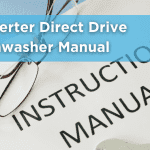Table of Contents
If you’re facing water in bottom of dishwasher, there are a few things that could be the problem. We understand how difficult it may be to get through this, and we’re here to assist. That’s why we put together these easy-to-follow steps that will guide you through troubleshooting the problem yourself without having to call a repairman.
You don’t need to spend money on an expensive service call when there are so many other options available to you! By following our simple instructions, you can save time and money while getting back to enjoying clean dishes again soon. Let us show you how!
Continue Reading to get the solution about How to Fix Standing Water in Dishwasher!
Troubleshooting Steps for Fixation
- Before you begin working on the dishwasher, shut off the electricity. This will prevent electric shock and keep you safe while servicing your appliance.
- To remove the water from a dishwasher: line your kitchen floor with towels and use a large cup or plastic container to scoop up as much of it as you can. When there’s too little fluid left for that method, start using towels until all the liquid is gone.
- Clean the pump: The upper impeller pumps water into your dishwasher, and the lower one pushes it out to drain. Sometimes, broken glass or other debris will stop this from happening, causing a buildup of water within the machine that could create damage to our appliance if not removed.
- Spray Arms Cleaning: Remove the sprayer arm from the bottom of your dishwasher carefully. Check for food debris and clean it with a wire hanger. Rinse off all pieces, set them aside to dry properly before putting them back in place.
- Dishwasher Filter: Cleaning the dishwasher filter is a good step in getting your dishes as clean and spotless as possible. If you want to do this safely, it’s best to first check where precisely the dishwasher filter is located (usually on the bottom of the floor near the back of the appliance) using manual or online instructions for reference. Now, use a screwdriver after removing the metal part with a screen attached from the surrounding area before rinsing off both parts thoroughly with water, making sure they are dry enough, so no rust will form later by wiping them carefully afterwards replacing all pieces together again.
- Drainage System: Is your dishwasher not draining? Food particles or other obstructions in the drainage system could be to blame. Check and clean any blocked drains around the lower sprayer arm with a wire hanger. Make sure no large things are hiding (the) sump area in the back of the tub, as this might cause future difficulties.
- Supply Line: If you are still experiencing an issue with standing water in your dishwasher, the supply line to the main drain has likely clogged. You can attempt to use a snake or even chemicals for this purpose if they do not work alone. If these options fail, contact a professional plumber since there could be further problems within your drainage system itself. Which have created blockages leading back up into the sink and subsequently dishwasher unit.
- Drain Line: Cleaning the drain line can be done by locating it near the back of a dishwasher and pouring 1/2 cup baking soda mixed with 1/2 cup water into it. Pour another half-cup vinegar down after, letting this sit for 15 minutes before flushing out with hot water to get rid of all residue and buildup in its path.
- Drain Hose Straightening: Locate the dishwasher drain hose under your sink. The end of this flexible tube typically holds up by clips or screws, but older ones tend to form kinks which can create blockages and prevent water from draining correctly. If you notice any kinks in it, gently straightened them out for a more efficient drainage system.
- Garbage Disposal: To unclog blockages with a flat-head screwdriver, start by removing the drain hose that connects the garbage disposal to the sink. After eliminating any clogs and ensuring that your kitchen sink isn’t clogged, run water through your sink for several minutes before rerunning the disposal. Never put your hands down on this crucial appliance as serious injury may result!
- Run a complete cycle: Check to see if anything has blocked the drain. After the cycle is finished, open the door and look for any water in the bottom of the dishwasher. If you find an unusual amount of standing water there, you may want to get service assistance from a home warranty provider after filing a claim with them.
Prevent Future Water Standing
Consider the following suggestions to avoid water accumulation in the future.
- Detergent: Use a quality detergent when running your dishwasher to avoid clogging the drain. If you need guidance, check out the manual for which type of powder or liquid is best suited to your machine and manufacturer guidelines on correct use.
- Loading Dishwasher: To ensure that all of your dishes are free from dirt and germs, it’s essential to load the dishwasher correctly. Read on for directions! First off, cups should be placed in the top rack while small bowls go into silverware holders or cutlery baskets. Plates should rest inside bottom racks, whereas big bowls can fit flat at a right angle against plates already resting there.
- Machine Sounds: During the cycle, listen for humming or clicking noises. If you heard a sound from the drain pump and motor, it means that they are malfunctioning. These components help to prevent standing water in dishwashers by keeping them functioning properly, therefore they should be replaced as soon as possible. Replace these parts immediately before they become non-functional and do more harm than good!
- Maintaining Dishwasher: Follow these steps to properly maintain your dishwasher. With the proper maintenance, you can avoid a broken dishwasher and get help with draining it correctly when needed. If you find that your washer keeps breaking down more than usual, consider getting home warranty coverage; this will offset some of those costs for repairs or replacements.
Right Time to Call a Professional!
If your dishwasher no longer drains, you may need to hire a professional. If the warranty has expired and it is not covered under the home warranty, call up the company to make a claim on your dishwasher so that they can send in an approved contractor who will fix or replace them for you.
A dishwasher repair or replacement depends on the situation. If it’s a quick fix, they’ll usually do that same day. However, if you need to schedule another appointment to install your new appliance because there is damage beyond their control or responsibility. You have to wait until that time comes around again and understand all terms related to this warranty plan before making any plans!
Warranty
If your dishwasher is no longer covered by warranty, you’ll want to conduct some research and set up an appointment with a reputable expert. The technicians will determine whether the problem can be resolved or if it must be replaced totally. Keep in mind that any repairs done without a warranty may require out-of-pocket costs from you! If necessary, they’ll provide recommendations for new appliances and installation services after purchase, so you don’t have to worry about those annoying dings on walls from leaning up against them during transport.
Conclusion
We hope that these steps helped fix your dishwasher. If you ever have any questions, don’t hesitate to contact our team of experts, email us at info@dishwasherguys.com, and we will be happy to help!





[…] clogged internally, the drainage pipe from your machine is blocked by debris, or you have a faulty water intake […]